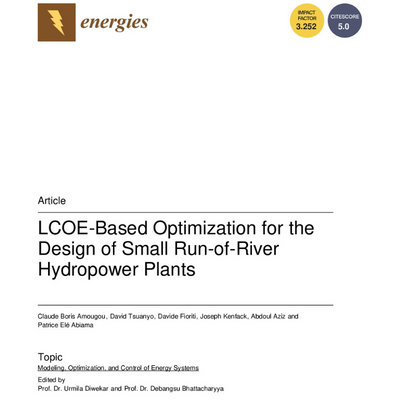SETaDiSMA, one of the projects within the LEAP-RE Portfolio aims to tackle the African mini-grid sector as a whole. Project partners Claude Boris Amougou, David Tsuanyo, Davide Fioriti, Joseph Kenfack, Abdoul Aziz and
Patrice Elé Abiama recently published an article “LCOE-Based Optimization for the Design of Small Run-of-River Hydropower Plants” in the Energies journal of the Multidisciplinary Digital Publishing Institute (MDPI).
A levelized cost of energy (LCOE)-based optimisation methodology for small run-of-river hydroelectric power plants was developed to calculate the number and characteristics of the turbines, penstocks and generators that could be used to harness the hydraulic potential of the river Nyong in Mbalmayo, Cameroon.
Abstract
Run-of-river hydropower plants are a cost-efficient technology that produce a power output proportional to the instantaneous flow of water diverted from the exploited stream by exploiting several mechanical, hydraulic, and electric devices. However, as no storage is available, its design and operation is tailored according to the unpredictability of its power generation. Hence, the modelling of this type of power plants is a necessity for the promotion of its development. Accordingly, based on models from the literature, this study proposes a comprehensive methodology for optimally designed small run-of-river hydropower plants based on a levelized cost of energy (LCOE). The proposed methodology aims at facilitating a faster design for more cost-effective and energy-efficient small hydropower plants. Depending on the average daily flow rates and the gross head of a given site, the model proposed in this study calculates the diameter, thickness, and length of a penstock; it also suggests the optimal selection of a turbine, determines the admissible suction head of a turbine for its optimal implementation, and determines the optimal number of turbines, all in order to minimize the LCOE of the proposed project. The model is tested to design a small run-of-river hydropower plant with a capacity of 6.32 MW exploiting the river Nyong in Mbalmayo. The results confirm the profitability of the investment with an LCOE of around 0.05 USD/kWh, which is the lowest limit value of the LCOE range for small hydropower plants, as presented in the IPCC (Intergovernmental Panel on Climate Change) report, assuming a project lifespan of 50 years and a discount rate of 12.5%. These results also show that it may be worth to provide the energy sector with a small hydropower design tool with a graphical interface. In addition, it would be appropriate to use a similar method in an off-grid context where a hydropower plant, with or without storage, is combined with another source to meet the electrical needs of a given population.
Next steps
It is envisaged that the study would provide a solid basis for scholars and developers that have an interest in developing preliminary feasibility studies for run-of-river hydropower plants in Sub-Saharan Africa, which are expected to be an important source of energy (especially for rural areas) with limited drawbacks.




